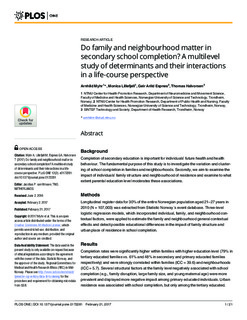| dc.contributor.author | Myhr, Arnhild Ramberg | |
| dc.contributor.author | Lillefjell, Monica | |
| dc.contributor.author | Espnes, Geir Arild | |
| dc.contributor.author | Halvorsen, Thomas | |
| dc.date.accessioned | 2019-03-01T13:40:15Z | |
| dc.date.available | 2019-03-01T13:40:15Z | |
| dc.date.created | 2017-06-15T13:47:19Z | |
| dc.date.issued | 2017 | |
| dc.identifier.citation | PLoS ONE. 2017, 12:e0172281 (2), 1-21. | nb_NO |
| dc.identifier.issn | 1932-6203 | |
| dc.identifier.uri | http://hdl.handle.net/11250/2588315 | |
| dc.description.abstract | Background Completion of secondary education is important for individuals’ future health and health behaviour. The fundamental purpose of this study is to investigate the variation and clustering of school completion in families and neighbourhoods. Secondly, we aim to examine the impact of individuals’ family structure and neighbourhood of residence and examine to what extent parental education level moderates these associations. Methods Longitudinal register data for 30% of the entire Norwegian population aged 21–27 years in 2010 (N = 107,003) was extracted from Statistic Norway´s event database. Three-level logistic regression models, which incorporated individual, family, and neighbourhood contextual factors, were applied to estimate the family and neighbourhood general contextual effects and detect possible educational differences in the impact of family structure and urban place of residence in school completion. Results Completion rates were significantly higher within families with higher education level (79% in tertiary educated families vs. 61% and 48% in secondary and primary educated families respectively) and were strongly correlated within families (ICC = 39.6) and neighbourhoods (ICC = 5.7). Several structural factors at the family level negatively associated with school completion (e.g., family disruption, large family size, and young maternal age) were more prevalent and displayed more negative impact among primary educated individuals. Urban residence was associated with school completion, but only among the tertiary educated. Conclusions Investment in the resources in the individuals’ immediate surroundings, including family and neighbourhood, may address a substantial portion of the social inequalities in the completion of upper secondary education. The high intra-familial correlation in school completion suggests that public health policies and future research should acknowledge family environments in order to improve secondary education completion rates among young people within lower educated families. | nb_NO |
| dc.language.iso | eng | nb_NO |
| dc.rights | Navngivelse 4.0 Internasjonal | * |
| dc.rights.uri | http://creativecommons.org/licenses/by/4.0/deed.no | * |
| dc.title | Do family and neighbourhood matter in secondary school completion? A multilevel study of determinants and their interactions in a life-course perspective | nb_NO |
| dc.type | Journal article | nb_NO |
| dc.type | Peer reviewed | nb_NO |
| dc.description.version | publishedVersion | nb_NO |
| dc.source.pagenumber | 1-21 | nb_NO |
| dc.source.volume | 12:e0172281 | nb_NO |
| dc.source.journal | PLoS ONE | nb_NO |
| dc.source.issue | 2 | nb_NO |
| dc.identifier.doi | 10.1371/journal.pone.0172281 | |
| dc.identifier.cristin | 1476406 | |
| cristin.unitcode | 7401,60,25,0 | |
| cristin.unitname | Helse | |
| cristin.ispublished | true | |
| cristin.fulltext | original | |
| cristin.qualitycode | 1 | |

